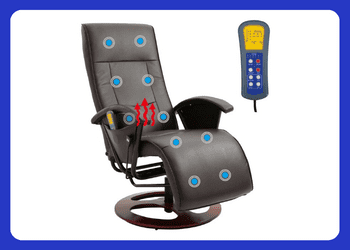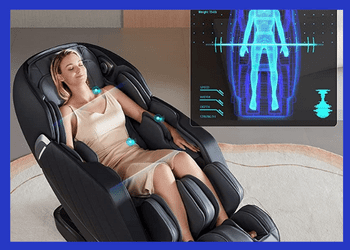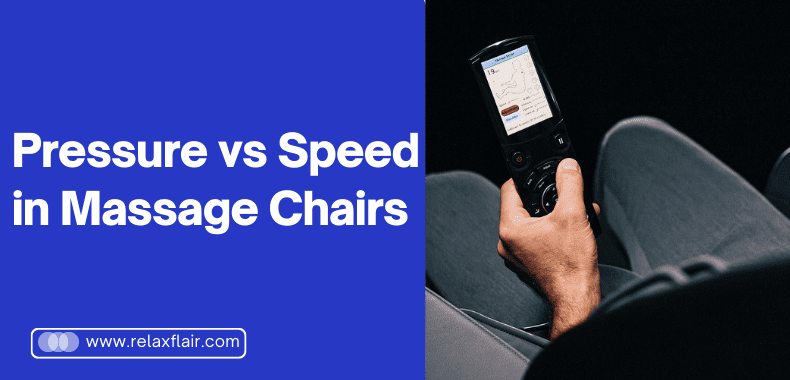Ready to indulge in a luxurious massage from the convenience of home? Look no further than massage chairs, technologically advanced furniture pieces that offer an array of therapeutic massaging techniques. Whether it’s kneading, rolling, or shiatsu – these chairs emulate the expertise of professional masseuses for a total relaxation experience.
Experiencing the full advantages of massage therapy, such as decreased stress levels, improved circulation and flexibility, and alleviation of chronic pain require mastering pressure and speed. A massage chair’s settings can alter both intensity and efficacy for each person’s aches or emotional state.
Therefore it is essential to find a fitting balance that works best for you. Get ready to delve into the fundamentals of pressure, intensity, and speed in massage chairs, comprehend their respective advantages, and identify which one is essential for a personalized massage. In this article let’s explore it all.
Pressure and Speed: Understanding the Basics
Whether you’re looking for a light and gentle massage or an intense deep tissue session, massage chairs are expertly crafted to deliver personalized relaxation. Pressure determines the intensity of your treatment while speed controls how quickly the rollers travel across your body – giving you full control over just how much relief you need!
A massage chair’s intensity and effectiveness can be adjusted with the right pressure and speed settings. If you prefer a more intense massage, opt for higher pressure; to achieve complete relaxation, select a slower speed setting.
Changes in pressure and speed should be taken into consideration when operating a machine. Generally, if you’re dealing with higher settings of pressure then the speed has to slow down; this is due to the fact that too much force at an accelerated rate can result in distress or even injury. However, lower levels of pressure don’t need such swiftness as they likely won’t give enough stimulation for them to work properly.
Massage chairs let users decide how much pressure and speed they want during their massage, while also offering various pre-programmed settings. But if you’re looking for a truly unique experience, some of the more advanced models come with sensors that detect body shapes and create a custom massage to fit your specific needs. So no matter what kind of massage you desire – from gentle relaxation to strong deep tissue work – these chairs guarantee an enjoyable session every time.
Not only can personalizing your massage chair experience provide multiple health benefits, but it is also essential to consider pressure and speed settings in order to prevent any injuries. It’s prudent, to begin with, low-pressure and slow-speed options before gradually increasing as needed – overstimulation or pain should be avoided at all costs. Above all else, talking with a healthcare provider prior to using the massage chair if you have an underlying medical condition is strongly advised for optimal safety.
In summary, pressure and speed are two important components in a massage chair that contribute to a personalized massage experience. They are closely related and must be adjusted appropriately to achieve the desired massage intensity and effectiveness. Massage chairs are designed to allow users to control pressure and speed, providing a safe and effective way to enjoy the benefits of massage therapy in the comfort of their own homes.
The Role of Intensity in a Massage Chair
One of the most important factors in the effectiveness of a massage is the intensity of the pressure applied. In a massage chair, pressure can be adjusted to suit the user’s needs, allowing for a customized massage experience. Pressure is essential for increasing circulation and promoting muscle relaxation, two key benefits of massage therapy.
 Massage chairs offer a variety of pressure types, including shiatsu, kneading, and rolling. Shiatsu massage is a Japanese massage technique that involves applying pressure to specific points on the body to promote relaxation and relieve tension.
Massage chairs offer a variety of pressure types, including shiatsu, kneading, and rolling. Shiatsu massage is a Japanese massage technique that involves applying pressure to specific points on the body to promote relaxation and relieve tension.
Kneading massage involves using circular motions to knead and stretch muscles, while rolling massage uses rollers to move up and down the back, mimicking the motion of a masseuse’s hands.
Adjusting pressure settings on a massage chair is easy and intuitive. Most massage chairs have a control panel that allows users to adjust pressure intensity, speed, and other settings. It’s important to start with lower pressure settings and gradually increase as needed to avoid overstimulation or discomfort.
Users can also focus on specific areas of the body, such as the neck or lower back, by adjusting the rollers to apply more pressure to those areas.
In addition to the physical benefits of massage, pressure intensity can also have psychological benefits. Higher pressure can help relieve stress and promote relaxation, while lower pressure can be more soothing and calming. It’s important to experiment with different pressure settings to find what works best for individual needs and preferences.
In summary, pressure intensity plays a crucial role in the effectiveness of a massage chair. Massage chairs offer a variety of pressure types, including shiatsu, kneading, and rolling, and adjusting pressure settings is easy and intuitive. The physical and psychological benefits of massage make it a valuable addition to any wellness routine.
Pressure vs Speed: Which is More Important?
An age-old question in the massage chair industry is whether pressure or speed should be prioritized for an optimal massage – both are essential elements, so which one truly reigns supreme?
When it comes to muscle relief, speed matters. Working at a faster rate can access and release deeper tissue knots more quickly than at slower speeds. However, going too fast can be uncomfortable and overstimulating, so gradually increase your speed until you find the right pace for you.
 Finding an equilibrium between pressure and speed is essential when selecting the perfect massage chair. And it’s even better if your chosen model offers adjustable settings, allowing you to tailor the experience to be as comforting or invigorating as you desire – for optimal results!
Finding an equilibrium between pressure and speed is essential when selecting the perfect massage chair. And it’s even better if your chosen model offers adjustable settings, allowing you to tailor the experience to be as comforting or invigorating as you desire – for optimal results!
It all comes down to individual needs and preferences. If muscle tension or knots are an issue, then more pressure with slow speeds is the ideal option for you. In contrast, if relaxation is desired from your massage session, then lower pressure combined with faster speeds could be the best choice.
In addition to the overall design, one must also think about the type of massage provided by the chair. Choose from a vast selection of massage chairs that offer varying pressure and speed programs such as shiatsu with gentle yet profound strokes or kneading with faster rhythmic motions.
In conclusion, pressure and speed are both important factors in achieving an effective massage in a massage chair. Finding a balance between the two is key to a customized massage experience that meets individual needs and preferences. It’s important to consider other factors as well, such as the type of massage offered by the chair, when choosing between pressure and speed.
Frequently Asked Questions
What Intensity Level is Osaki Massage Chair?
Osaki chairs guarantee a massage experience that ranges from medium-strong to extreme, including deep tissue. In comparison, the Synca CirC model is more compact and offers a much softer massage.
How Do I Reduce the Intensity of My Massage Chair?
Additionally, to minimize the intensity, you can adjust the chair angle to a more upright posture. The closer it is to this position, the gentler your massage will be. The Massage Auto Programs provide an even higher level of intensity with their kneading technique as well.
What Does 4D Massage Chair Mean?
A 4D massage chair is a type of massage chair that provides a multidimensional massage experience. Unlike traditional 2D or 3D massage chairs, 4D massage chairs allow for more customized massage sessions by offering additional depth, speed, and intensity adjustments.
The “4D” refers to the fourth dimension, which is time, and allows for the massage rollers to move in a more dynamic and natural way. This means that users can enjoy a massage that feels more like the hands of a professional masseuse, with the added convenience and comfort of being able to enjoy it in their own homes.
When Not to Use a Massage Chair?
Massage chairs can be a boon for relaxation and muscle relief, but there are certain conditions and scenarios where their use can be contraindicated or even harmful. Understanding these specific situations is crucial to avoid adverse effects and ensure safety.
1. Acute Injuries
Using a massage chair during the acute phase of an injury, such as a recent sprain, strain, or fracture, can exacerbate inflammation and pain. The mechanical movements and pressure applied by the chair may aggravate the injured area, delaying the healing process. It is advisable to consult a healthcare professional before using a massage chair if you have any recent injuries.
2. Certain Medical Conditions
Individuals with certain medical conditions should avoid using massage chairs. For instance, people with severe osteoporosis might risk fractures due to the pressure exerted by the chair. Similarly, those with cardiovascular conditions, such as hypertension or heart disease, should be cautious, as the massage could potentially alter blood pressure and heart rate. Furthermore, individuals with deep vein thrombosis (DVT) should avoid massage chairs to prevent the risk of dislodging a blood clot.
3. Pregnancy
Pregnant women, particularly in the first trimester, should use massage chairs with caution. The mechanical pressure can affect blood circulation and potentially stimulate uterine contractions. Always consult with a healthcare provider before using a massage chair during pregnancy to ensure it is safe for both mother and baby.
4. Post-Surgical Recovery
After surgery, the body needs time to heal, and using a massage chair too soon can interfere with the recovery process. The vibrations and pressure might disrupt surgical sites, hinder proper healing, or cause discomfort. It is essential to follow the surgeon’s advice regarding the appropriate time to resume such activities.
5. Skin Conditions and Infections
People with certain skin conditions, such as eczema, psoriasis, or open wounds, should avoid massage chairs to prevent irritation or infection. The friction and pressure can aggravate these conditions, leading to further complications.
6. Sensory Impairments
Individuals with sensory impairments or neuropathy may not accurately perceive the intensity of the massage, risking injury or burns from prolonged pressure. Those with conditions like diabetes, which can cause nerve damage, should be particularly cautious and seek medical advice before use.
In summary, while massage chairs offer numerous benefits, they are not suitable for everyone. Awareness of the above contraindications can help prevent potential risks and ensure that massage therapy remains a safe and beneficial experience. Always consult with a healthcare professional if you have any doubts or pre-existing conditions before using a massage chair.
Conclusion
In conclusion, pressure and speed are both crucial factors in achieving an effective massage experience in a massage chair. Pressure promotes muscle relaxation, increases circulation, and relieves tension and stress, while speed allows for a deeper massage, reaching deeper muscle tissue, and relieving tightness and knots.
However, finding the right balance between pressure and speed is essential for a personalized massage experience that meets individual needs and preferences. Prioritizing one over the other can have drawbacks, and it’s important to start with lower settings and gradually increase as needed to avoid discomfort or pain.
The debate between pressure and speed in massage chairs will continue, and it’s important to consider other factors such as the type of massage offered by the chair when making a choice. In the end, the right balance will depend on individual needs and preferences, and finding it will lead to a customized massage experience that provides the greatest benefits for each user.
So, whether you’re looking for stress relief, muscle relaxation, or a deeper massage, keep in mind the importance of pressure and speed and find the right balance for your personalized massage experience. Your body will thank you for it.
